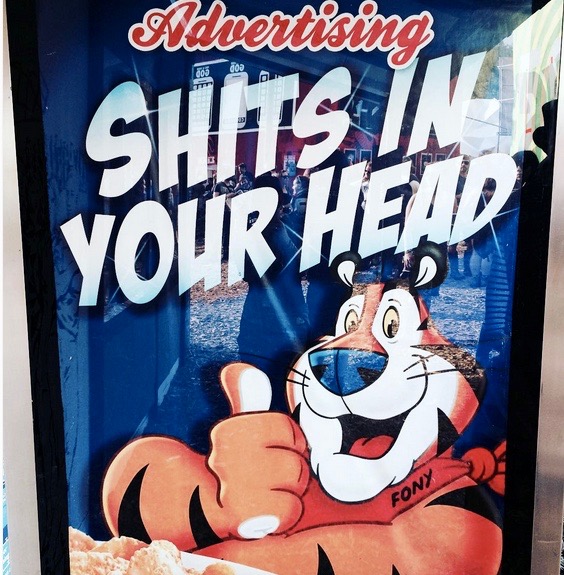Connect with execs from The New York Times, TIME, Dotdash Meredith and many more

Mark Duffy has written the Copyranter blog for 10 years and is a freelancing copywriter with 20-plus years of experience. His hockey wrist shot is better than yours.
Is it all just a big waste of space, time and money? I’m talking about all types of advertising here: internet, native, TV, video, mobile, print, branded content, matchbooks, stunts, product placement, sandwich boards. All of it.
I think it just might be.
I see you all scrambling to bring up your latest “engagement” numbers. But each and every one of those numbers is based on a different “formula” than the next one. It’s all skewed — sometimes completely made-up — bullshit, and you know it. “Clicks” mean nothing. “Views,” even, mean nothing. “Engage” with that.
Native advertising (and other branded content) doesn’t work — nobody remembers the brand. In one survey, two-thirds of those who recalled seeing a native ad remembered absolutely nothing about it, and 95 percent of them didn’t remember who the sponsor was.
Two years ago, The Atlantic asked a “dangerous question”: Does Internet Advertising Work at All? Short answer: probably not! Long answer: nobody knows. Nobody. Not even your Ad Tech Daddy, “Big Data.” This includes all Facebook ads and Google search ads: All of them are very likely useless. And nothing’s changed about that answer in 2016.
How about social media advertising — all those retweets and likes must add up to something? Yes, they add up to approximately nothing worth anything: Only 5 percent of people say social media has “a great deal of influence” on their purchasing decisions, according to a 2014 Gallup State of the American Consumer report; 30 percent copped “some influence.”
But what about the hallowed traditional creative advertising? Being an old school copywriter, I love to say “creativity” is the magical secret to effective advertising, the pixie dust that can’t be measured by an algorithm. More specifically, it’s the “unexpected great visual” that is the key to advertising that works, that sells.
But how do I know it works? It just does, because it has consistently worked since the Creative Revolution of the ’60s.
But, uh, that Revolution appears to have run its course.

Millennials, apparently, are — somehow — immune to advertising, even creative ads and videos with great visuals and crackling copy. Way to kill my career, assholes.
What should a brand do, then? Whelp, it definitely should stop spending money on advertising its products. Immediately. And give up on your marketing MBA bullshit: no hard sells, no soft sells, no devious sells … no selling!
Your only options left are to non-sell or un-sell. Here are some examples.
Un-ad ads are becoming more and more popular. Although they are still obviously ads, young folk seem to like their attitude. One of the most famous un-ads was E-Trade’s 1999 Super Bowl spot “we just wasted two million dollars,” though that ad still had too much “selling” copy at the end.
Below is a better more recent un-ad example for Seth & Riley’s Garage hard lemon. The self-deprecating tagline is a nice touch, too. Agency: Duval Guillaume. See more un-ad examples here.

Then, there is the non-sell. This is tough to pull off. One way to do it is cause or issue advertising, or as it’s called now, “causevertising.” But you can’t do in a transparently disingenuous way, like the terrible Dove “Real Beauty” hooey. You have to truly champion a cause 100 percent and never stick your logo and stupid tagline or #hashtag at the end of it, dummies. The Youngs will find out you did it, don’t you worry.
In lieu of selling, you must entertain or inform potential customers. Do some of that newfangled “storytelling!” Again, forget your brand. Nobody wants to watch a snoozy tale about the “legacy” of your car or beer or hemorrhoid cream. You need to create funny or interesting short “films” (with neither hide nor hair of your brand). You need to invent cool video games or a useful app and give them away for free. Millennials expect lots of free stuff (believe me, I’ve seen this at BuzzFeed). But whatever you make better be damn good/damn funny, or you will be brutally mocked by the digital native commentariat.
Don’t worry, you can pay for these projects easily with your old ad budget. If your current traditional or digital agency won’t get on board with your new strategy, fire them and find a shop or collection of freelancers who can and will.
Advertising may or may not be dead, but in almost all of its current forms, it sure as shit ain’t working.
More in Marketing

WTF is ‘Google Zero’?
The era of “Google Zero” — industry shorthand for a world where Google keeps users inside its own walls — is here.

The next browser wars are here — and AI wants the ad dollars too
Perplexity and OpenAI are getting ready to take on Google’s Chrome, but will need a solid ad business to keep their browsers ticking along.

Vista Equity Partners’ TripleLift implements ‘significant’ layoffs
The latest round of layoffs is understood to have impacted all departments at the SSP across multiple geographies.





